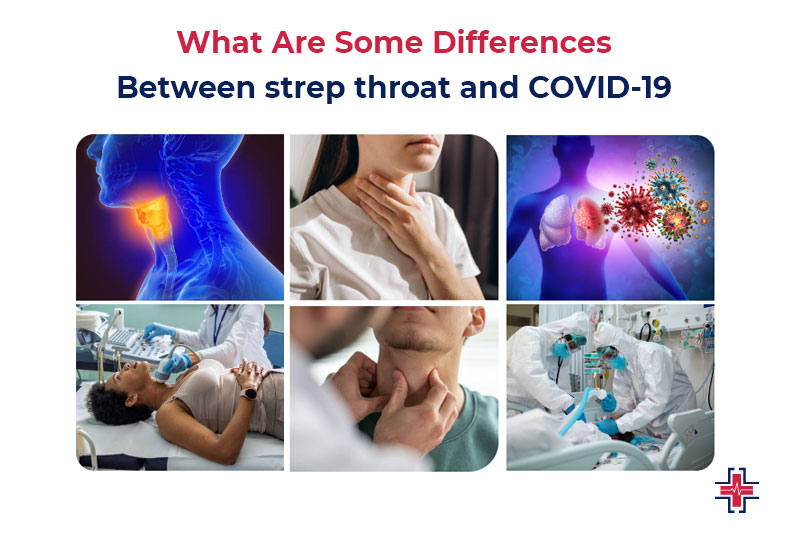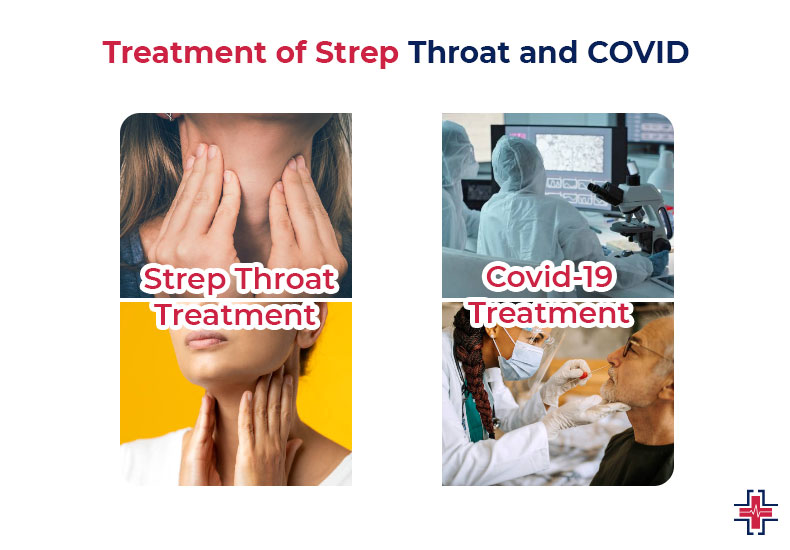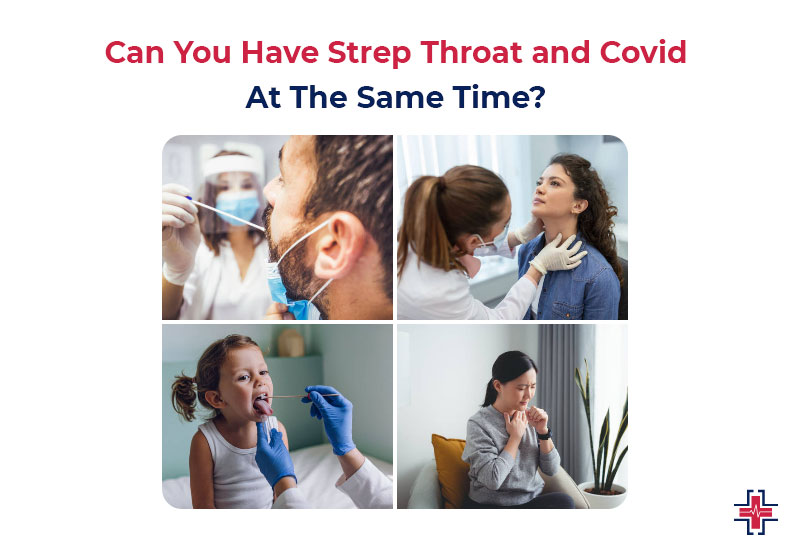People may first develop a mild to moderate sore throat at the beginning of the illness. This soreness could make swallowing uncomfortable and result in a scratchy or dry feeling in the throat. Some patients may also experience a persistent cough as the illness worsens, which can aggravate their throat pain and cause irritation.
People infected with COVID-19 may experience distinct stages of symptoms during the illness, varying in intensity and duration. While some people may suffer more severe respiratory problems, others may simply experience moderate symptoms. Frequent signs and symptoms of COVID-19 include fever, exhaustion, headaches, body aches, shortness of breath, and loss of taste or smell. In certain circumstances, reports of digestive symptoms such as nausea, vomiting, or diarrhea have also been made.
What is Strep Throat?
A scratchy, uncomfortable feeling in the back of your throat is called a sore throat. Speaking of swallowing may pain if you have a sore throat. Sore throats can be caused by a variety of factors, including allergies, sleeping with your mouth open, and bacterial and viral infections. The majority of sore throat symptoms pass after a few days. If your sore throat worsens, lasts more than a week, or you experience other symptoms like fever or swollen lymph nodes, you should see a doctor.
What is COVID?
Coronaviruses are a family of viruses that can cause respiratory illness in humans. They are called “corona” because of crown-like spikes on the surface of the virus. Severe acute respiratory syndrome (SARS), Middle East respiratory syndrome (MERS), and the common cold are examples of coronaviruses that cause illness in humans.
The new strain of coronavirus — SARS-CoV-2 — was first reported in Wuhan, China in December 2019. It has since spread to every country around the world.
What Are Some Differences Between Strep Throat and COVID-19?
The majority of us are familiar with the unpleasant sensations connected to a sore throat.
Your voice may become raspy or hoarse, your throat may feel dry or scratchy, and the lymph nodes in your neck may swell or engorge.

Speaking and swallowing may become difficult as the sore throat gets worse. Other symptoms including a fever, chills, cough, body pains, headaches, or runny nose may also be present.
On the surface of your tonsils or the roof of your mouth, red or white patches may occasionally occur. It’s critical to identify the underlying cause of your sore throat symptoms.
A painful throat is one of the COVID-19 symptoms that is shared by certain strep throat patients. Consequently, the majority of people become concerned when they awaken to a sore throat. However, having a sore throat does not always indicate that you have COVID-19.
It may be less difficult to manage your fear of getting the new coronavirus and take precautions for your loved ones if you understand the distinction between strep throat and COVID-19. Let’s compare and contrast the two ailments, concentrating on their causes, manifestations, and courses of therapy.
Numerous illnesses could be the cause: allergies, viral infections, bacterial infections, and non-infectious conditions can all cause throat pain.
Determining what ails you will enable you to treat your pain efficiently and, if you have an infection, prevent others from being infected.
The symptoms of strep throat and COVID-19 illnesses that might result in a sore throat will be discussed in this article.
Causes of Strep Throat and Covid At The Same Time
Despite being respiratory disorders, strep throat and COVID-19 have quite distinct causes. The bacterium Streptococcus pyogenes, also referred to as group A Streptococcus, is the source of strep infections. Even though this bacterial infection is not as serious as COVID-19, untreated cases may result in consequences.
Conversely, the virus that causes COVID-19 is called Severe Acute Respiratory Syndrome Coronavirus 2 (SARS-CoV-2). SARS-CoV-2 belongs to a class of viruses that can infect both people and animals. According to scientists, the novel coronavirus strain first infected pangolins or bats before spreading to people in Wuhan, China.
Symptoms of Strep Throat and Covid-19
Even though they hurt, sore throats are not uncommon. People may experience dryness or discomfort at the back of their throat when they have a sore throat.
The glands in their neck and jaw may start to swell, their voice may become scratchy or raspy, and they may find it difficult to swallow comfortably.
A sore throat can be caused by several illnesses, such as COVID-19 and strep throat. Although the disorders’ symptoms are similar, physicians and patients can distinguish between the two in a few ways.
The first step in treating your illness and protecting your friends and family from COVID-19 is to recognize the similarities and distinctions between the two infections.
A word of caution: Call your doctor to discuss your symptoms and arrange for a polymerase chain reaction (PCR) test if you are worried about your sore throat and think you could have COVID-19.
Until you can receive medical attention, isolate yourself at home. Maintain this isolation until the results of your test are negative.
To ensure they are ready for your visit, always give your doctor’s office, testing facility, or hospital a call in advance to let them know you might have COVID-19 or that you may have been exposed to it.
Comparable Symptoms
Even though separate infectious organisms cause each ailment, it can be challenging for a patient to differentiate between the symptoms of strep throat and COVID-19 they share certain identical characteristics.
Among them are possible:
- Vomiting or feeling queasy
- High temperature
- Gastrointestinal
- Inflamed or painful throat
- Headache
- Swelling of the jaw, face, or neck lymph nodes
If you are trying to distinguish between COVID-19 and strep throat, take note of how rapidly your symptoms appear.
While COVID-19 symptoms frequently manifest more gradually, symptoms of strep throat typically manifest quite fast.
It is also worth noting that although nausea and vomiting are prevalent in adults with COVID-19, children with strep throat typically have a higher likelihood of experiencing those particular symptoms.
Strep Throat Symptoms
Only a few signs set mild cases of strep throat apart from COVID-19 and other painful throat causes. When they have strep throat, many people have one or more of the following symptoms:
- Swelling, red tonsils
- Little reddish dots or lumps on the palate
- The tonsils have patches or white areas.
- They don’t cough at all.
- Pus-filled streaks on the tonsils
- High temperature
You may have signs of strep throat if you notice streaks or patches in your mouth. To arrange for a strep test and receive a precise diagnosis, give your doctor a call. Your doctor might recommend an antibiotic course to treat your throat infection and ease your discomfort if your test results are good.
COVID-19 Symptoms
While some COVID-19 patients report symptoms of sore throat resembling strep throat and other illnesses, the majority also have a variety of other respiratory-related issues.
The majority of individuals with COVID-19 symptoms, according to researchers at the Centers for Disease Control (CDC), encounter one or more of the following symptoms:
- Cough
- Inflammatory response
- Breathing difficulties
- Weary
- Aches in the body
- Diarrhea-like symptoms in the digestive system
- Restricted or obstructed nasal passageways
- Rash on the skin
- Runny nose
- Loss of aroma or taste
While many COVID-19 instances may be treated at home, in extreme cases, some people may experience life-threatening symptoms that necessitate emergency care, such as:
- Losing consciousness
- Pressure or pain in the chest
- Skin, lips, or nails that are pale, blue, or gray
- Breathing problems or breathlessness
- Perplexity
- Overwhelming exhaustion
Call 911 or visit the closest emergency room if you are seriously ill to receive medical attention.
If you want to visit any medical facility, make sure to give them a call in advance so they can get ready for you securely.
Treatment of Strep Throat and COVID
The problem causing your sore throat will determine how you should be treated. Antibiotics on prescription can be used to treat bacterial infections such as strep throat. Antibiotics are not used to treat viral infections such as COVID-19, the flu, and the common cold; instead, other drugs are used to relieve the symptoms and improve your quality of life.

Strep Throat Treatment
When group A Streptococcus bacteria get into your mouth or nose and start to multiply, it can cause strep throat. When an infected individual laughs, coughs, or talks, the bacteria enter your body by respiratory droplets from their body.
After being exposed to the illness, strep throat symptoms often appear two to five days later. Youngsters are especially susceptible to strep throat because they are more likely to come into touch with germs in childcare centers, schools, and playgrounds.
The best course of action if you think you have strep throat is to call your doctor and request a fast strep test in order to receive a diagnosis and treatment. To find out if you test positive, they will swab the inside of your throat.
Your doctor may conduct a throat culture swab to confirm the diagnosis if you don’t test positive but they still think you have strep throat.
While taking longer, throat culture swab results are thought to be more accurate than those obtained quickly. Your doctor will prescribe an antibiotic to treat your bacterial infection and relieve your symptoms as soon as they have determined that you have strep throat.
Typical antibiotics consist of:
- Cephalexin, also known as Keflex
- Amoxil, or amoxicillin
- Penicillin
- Zithromax, or Azithromycin
- Biaxin (clarithromycin)
- Cefixime (Suprax)
- Clediacin (clindamycin)
- Cefuroxime, also known as ceftin
Even if you begin to feel better, you should always take your antibiotics exactly as directed and for the entire recommended duration. You face the danger of getting your throat infection back if you stop taking your medicine before your doctor advises you to.
Covid-19 Treatment
Since viruses don’t react to antibiotics, treating viruses like COVID-19 and other illnesses is more difficult than treating bacterial infections.
While researchers continue to work on COVID-19 drugs, the FDA has only authorized a small number of them. The majority are saved for serious situations that need hospitalization. The majority of medical professionals advise treating COVID-19 the same way you would a regular cold for those with less severe symptoms.
- Get some sleep.
- Make sure to stay hydrated.
- Use over-the-counter drugs to alleviate your discomfort.
- Wash your hands frequently for at least 20 seconds at a time, using warm water and soap.
- Refrain from interacting with others, but if you must, wear a N95 or KN95 mask. Don’t share dishes, utensils, towels, blankets, or other personal things.
- Keep surfaces clean on a regular basis.
- Try to limit your contact with other people in order to prevent the spread of your disease.
- Get assistance from others to perform errands or buy groceries.
Watch your health very carefully while you recover from COVID-19. Mild symptoms might occasionally suddenly worsen to the point where they need immediate medical attention.
Call the clinic or hospital in advance if you think you need to see a doctor straight away so they can get ready for you.
The greatest defense against contracting COVID-19 is to wear the appropriate personal protective equipment (PPE) when in public areas and to get vaccinated and boosted as soon as feasible.
Vaccinating against COVID is a secure and practical approach to keep your loved ones safe and prevent serious sickness.
Can You Have Strep Throat and Covid At The Same Time?
However, it is conceivable to have COVID-19 and strep throat at the same time. It is feasible to simultaneously have strep throat and a viral illness. The simplest approach to determine whether a sore throat is caused by a virus, group A strep, or both is to pay a quick visit to your doctor.

When to Get Medical Help
Speak with your healthcare physician if you think COVID-19 or strep throat is the cause of your symptoms. After making a diagnosis, they will recommend a course of action that will help you feel better.
Following your diagnosis, keep an eye on your symptoms.
- You may need emergency care for strep throat if you start to have more serious symptoms, such as breathing difficulties, confusion, chest discomfort, extreme exhaustion or insomnia, or pale, gray, or blue skin, lips, or nails.
- You ensure that the hospital can safely prepare for your arrival, make sure you phone ahead when you arrive there or contact 911.
In Brief
One typical COVID-19 symptom is a sore throat. It may manifest as a single symptom or as an early symptom. With COVID-19, it is also possible to avoid having a sore throat.
Stay at home and give your doctor a call if you start to feel like you could have COVID-19 and have a sore throat. Regarding testing and therapy, they can offer you advice.
Lozenges, sprays, and over-the-counter painkillers can all be used to treat sore throat pain and discomfort. Think about other methods to help relieve your painful throat, such resting your voice and consuming cold meals and beverages.
In addition to other therapies, your healthcare professional may recommend an antiviral medicine based on your health state and symptoms.
You can get a primary care physician online, did you know that?
Examine your symptoms, research ailments and therapies, and, if necessary, text a medical professional in minutes with Emergency Room in Mesquite.
